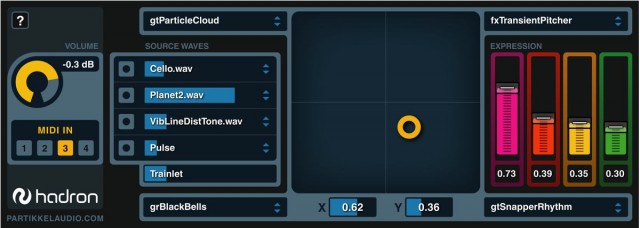Synthesizers can sometimes seem stuck in a groove, an endless, repeating parade of identical virtual analog synths. If you want something different, the Hadron Particle Synthesizer could fit the bill.
It’s a synth. It’s a sampler. It’s an effect. It’s a synth that can morph from synth to sampler to effect. Based on granular synthesis, sound is transformed into new sonorities, sometimes liquid, sometimes stuttering, layered here for even more complex sounds.
Earlier versions ran in the sophisticated, evergreen sound-coding tool Csound, and in Max for Live. But if you felt left out, a new version now works as a VST and AU plug-in on Windows and Mac – and it’s still free. The business model appears to be selling expansion packs, so if you like these instruments, give the developers some support by grabbing the expansions.
Whichever version you get, you get the underlying Csound code free, covered by an open source license, so those of you who are so motivated can learn a bit about the code that makes the granular magic work.
It’s a synth, but also an effect – and, for a twist, can seamlessly morph between the two, going from sound source to sound processor and shades in between. Its layering, parameter control, expression options, and all-around completeness lead its developers to confidently dub it “particle synthesis” and not just “granular synthesis.” And what may really convince you, it’s completely free, open source, runs and runs at release either inside Ableton Live as a Max for Live or within the free, geekily-delicious tool Csound. (Plug-ins for Mac and Windows are coming, too.) Whew. Now you’ve got my attention.
If it’s not making sense why this is so cool, we have new video evidence. Since we last covered Hadron, the Norwegian creators have cooked up demos showing how this works as an instrument with input from voice:
As the developers say:
We can still proudly announce Hadron as a unique crossbred beast that can assume the role of synthesizer, sampler or audio effect, all while being able to seamlessly morph between these different sound processing methods, so you can take the plugin gradually from being a synthesizer to an audio effect for live input. At the core of this unique morphing capability lies an extremely versatile processing engine based on granular synthesis as implemented in Csound. In fact Hadron is such a complete implementation of granular synthesis we’ve renamed the technique to particle synthesis.
Grab the free downloads and other Partikkel creations:
http://www.partikkelaudio.com/
You’ll also find Ableton Live sets and TouchOSC templates to help you enjoy the instrument.
And if you’re curious what this Csound business is all about, it’s only the digital synthesis tool that launched them all:
http://www.csounds.com/
I’ll be giving those expansion packs a try, as well. Hmmm… maybe I’d better actually produce some music with this stuff, huh?
